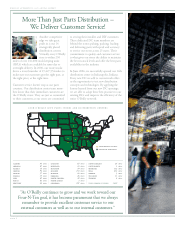O'Reilly Auto Parts 2006 Annual Report Download - page 20
Download and view the complete annual report
Please find page 20 of the 2006 O'Reilly Auto Parts annual report below. You can navigate through the pages in the report by either clicking on the pages listed below, or by using the keyword search tool below to find specific information within the annual report.
o’reilly automotive 2006 annual report
page 18
management’s discussion and analysis
of financial condition and results of operations
The following discussion of our financial condition, results of operations and liquidity and capital resources should be read in conjunction with our consolidated
financial statements, related notes and other financial information included elsewhere in this annual report.
We are one of the largest specialty retailers of automotive aftermarket parts, tools, supplies, equipment and accessories in the United States, selling
our products to both do-it-yourself (DIY) customers and professional installers. Our stores carry an extensive product line consisting of new and
remanufactured automotive hard parts, maintenance items and accessories and a complete line of auto body paint and related materials, automotive
tools and professional service equipment.
We calculate same-store sales based on the change in sales for stores open at least one year. We calculate the percentage increase in same-store sales
based on store sales results, which exclude sales of specialty machinery, sales by outside salesmen and sales to team members.
Cost of goods sold consists primarily of product costs and warehouse and distribution expenses. Cost of goods sold as a percentage of sales may be
affected by variations in our product mix, price changes in response to competitive factors and fluctuations in merchandise costs and vendor programs.
Operating, selling, general and administrative expenses consist primarily of salaries and benefits for store and corporate team members, occupancy costs,
advertising expenses, depreciation, general and administrative expenses, information technology expenses, professional expenses and other related expenses.
critical accounting policies and estimates
The preparation of our financial statements in accordance with accounting policies generally accepted in the United States (“GAAP”) requires the
application of certain estimates and judgements by management. Management bases its assumptions, estimates, and adjustments on historical experience,
current trends and other factors believed to be relevant at the time the consolidated financial statements are prepared. Management believes that the
following policies are critical due the inherent uncertainty of these matters and the complex and subjective judgments required to establish these estimates.
Management continues to review these critical accounting policies and estimates to ensure that the consolidated financial statements are presented
fairly in accordance with GAAP. However, actual results could differ from our assumptions and estimates and such differences could be material.
■Vendor concessions – We receive concessions from our vendors through a variety of programs and arrangements, including co-operative advertising,
allowances for warranties, merchandise allowances and volume purchase rebates. Co-operative advertising allowances that are incremental to our
advertising program, specific to a product or event and identifiable for accounting purposes, are reported as a reduction of advertising expense in
the period in which the advertising occurred. All other vendor concessions are recognized as a reduction to the cost of inventory. Amounts receivable
from vendors also include amounts due to the Company for changeover merchandise and product returns. Amounts receivable from vendors are
regularly reviewed by management and reserves for estimated uncollectible amounts are provided for in our consolidated financial statements.
We do not believe there is a reasonable likelihood that uncollectible amounts will exceed management’s expectations. However, actual results could
differ from our assumptions and estimates, and we may be exposed to losses or gains that could be material.
■Self-Insurance reserves – We use a combination of insurance and self-insurance mechanisms to provide for potential liabilities from workers’
compensation, general liability, vehicle liability, property loss and employee health care benefits. With the exception of employee health care benefit
liabilities, which are limited by the design of these plans, we obtain third-party insurance coverage to limit our exposure for any individual claim.
When estimating our self-insurance liabilities, we consider a number of factors, including historical claims experience and trend-lines, projected
medical and legal inflation, and growth patterns and exposure forecasts. Our calculation of these liabilities requires management to apply judgment
to estimate the ultimate cost to settle reported claims and claims incurred but not yet reported as of the balance sheet date. Actual claim activity or
development may vary from our assumptions and estimates, which may result in material losses or gains.
■Accounts receivable – Management estimates the allowance for doubtful accounts based on historical loss ratios and other relevant factors. Actual
results have consistently been within management’s expectations and we do not believe that there is a reasonable likelihood that there will be a
material change in future assumptions or estimates we use to calculate our allowance for doubtful accounts. However, if actual results differ from
our estimates, we may be exposed to losses or gains that could be material.
■Ta x e s – We operate within multiple taxing jurisdictions and are subject to audit in these jurisdictions. These audits can involve complex issues,
which may require an extended period of time to resolve. We regularly review our potential tax liabilities for tax years subject to audit. Changes in
our tax liability may occur in the future as our assessments change based on the progress of tax examinations in various jurisdictions and/or changes
in tax regulations. In management’s opinion, adequate provisions for income taxes have been made for all years presented. However, the estimates
of our potential tax liabilities contain uncertainties because management must use judgment to estimate the exposures associated with our various
tax positions. Actual results could differ from our estimates and such differences could be material.
■Share-based compensation – Prior to January 1, 2006, the Company accounted for its share-based compensation plans under the provisions of Accounting
Principles Board Opinion No. 25, Accounting for Stock Issued to Employees (“APB No. 25”), as permitted under Statement of Financial Accounting Standards
No. 148, Accounting for Stock-Based Compensation - Transition and Disclosure - an amendment of FASB Statement No. 123. Effective January 1, 2006, the
Company adopted SFAS No. 123R, “Share Based Payment,” under the modified prospective method. Accordingly, prior period amounts have not been
restated. Under this application, the Company records share-based compensation expense for all awards granted on or after the date of adoption and
for the portion of previously granted awards that remain unvested at the date of adoption. Currently, the Company’s share-based compensation relates
to stock option awards, employee share purchase plan discounts, restricted stock awards and shares contributed directly to other employee benefit plans.
Under SFAS No. 123R, the Company uses a Black-Scholes option-pricing model to determine the fair value of its stock options. The Black-Scholes model
























